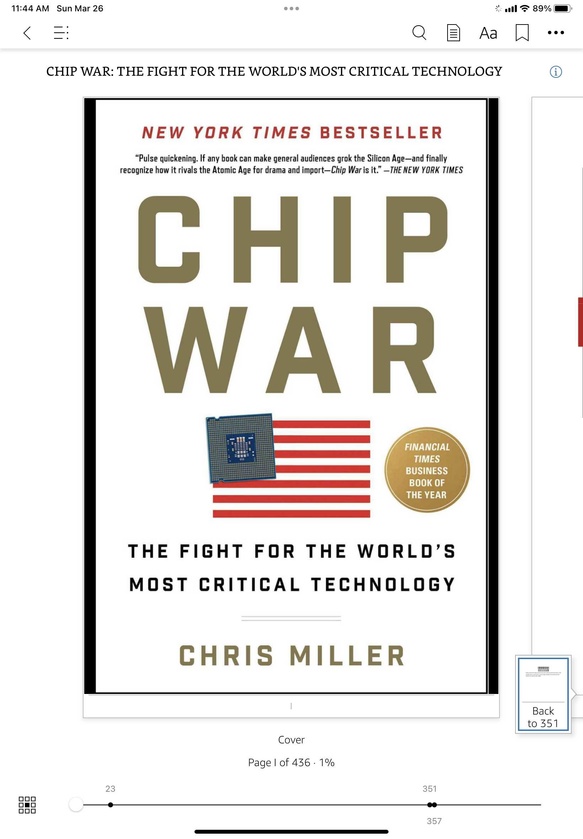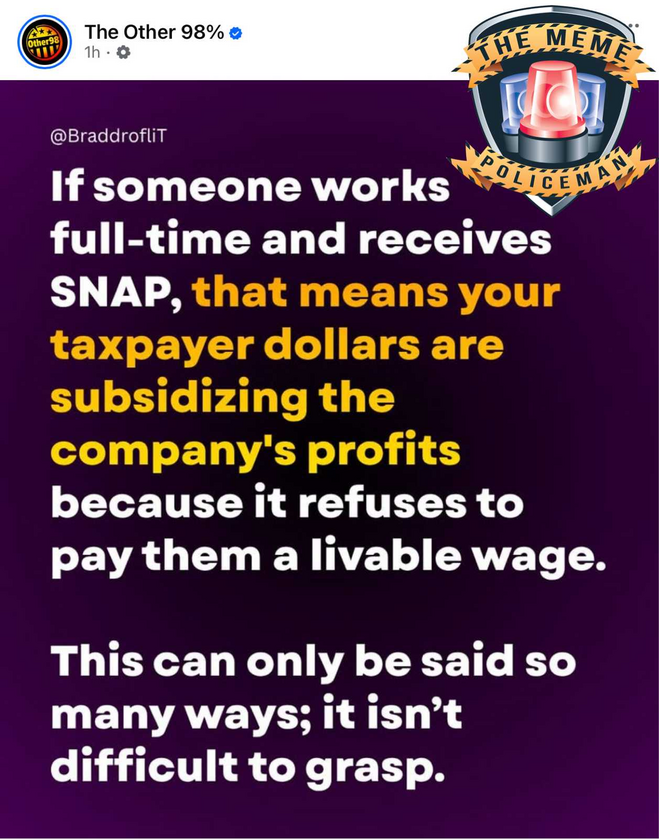▪️In honor of Intel founder Gordon Moore’s recent passing, here’s my recap of Chip War, the fascinating history of semiconductors, which are arguably the most important goods produced today. Yet, most of us are completely ignorant of how they came about, what it takes to produce them and who produces them.
▪️Chips are crucial in everything from smart phones & TVs to guided missiles & dishwashers. A new car can have over 1,000 chips in it! The modern economy, as well as military, is dependent on them. In many ways they are even more crucial than oil, because a nation can’t simply start producing cutting edge chips, even if they wanted to.
▪️The first semiconductors, developed in the 1950s, were amazing feats of technology brought about by brilliant scientists and engineers in the US. They became known colloquially as a “chip,” because each integrated circuit was made from a piece of silicon “chipped” off a circular silicon wafer. They quickly replaced inferior vacuum tubes in early computers.
▪️One of the first commercial chips, made by Fairchild Semiconductors in 1961, had 4 transistors. That was cutting edge. Now, Apple alone sells hundreds of millions of iPhones, each powered by a chip with 11.8 BILLION tiny transistors carved into its silicon.
▪️Some of these chip components are just atoms thick, consisting of complex mazes of transistors smaller than half of a coronavirus. Yet they are mass produced, billions of integrated transistors working almost flawlessly in your devices. Last year, the chip industry produced more transistors than the combined quantity of all goods produced by all other companies, in all other industries, in all human history.
▪️A group at Fairchild Semiconductors spun off and formed Intel in 1968. Among those founders was Gordon Moore, who made perhaps the most important prediction of the 20th century, now called “Moore’s Law.” This predicted the doubling of transistors in a chip ~every two years.
▪️This wasn’t achieved by some law of physics but by the relentless & amazing efforts from companies like Intel, Texas Instruments, then later Sony, Micron, Samsung, AMD & TSMC. The ability to cram ever more transistors into a tiny chip is an achievement that sounds like it’s from an advanced alien civilization.
▪️As chips became more complex, the manufacturing became more specialized, and now often only one company has the expertise to make cutting edge components. One of the key elements in chip making is lithography, the process of printing tiny transistors onto silicon with light.
▪️In early chips, light was focused and reflected by lenses/mirrors to draw patterns on photoresist paper made by Kodak. As the size of the patterns shrank with Moore’s Law, they needed to use UV light, because visible light waves were too large! Eventually, even UV light waves were too large, so they moved to extreme UV (EUV).
▪️Now, a single Dutch company, ASML, builds 100% of the world’s extreme ultraviolet (EUV) lithography machines, without which cutting-edge chips are simply impossible to make. Producing EUV is unbelievably complex, here’s how the American company Cymer does it for ASML:
🔹“shoot a tiny ball of tin measuring thirty-millionths of a meter wide moving through a vacuum at a speed of around two hundred miles per hour. The tin is then struck twice with a laser, the first pulse to warm it up, the second to blast it into a plasma with a temperature around half a million degrees, many times hotter than the surface of the sun. This process of blasting tin is then repeated fifty thousand times per second to produce EUV light in the quantities necessary to fabricate chips.”
▪️To achieve this, they need a specialized laser, only built by the German company Trumpf. This laser is so precise and stable it could hit a golf ball as far away as the moon. Another German company, Zeiss, produces the specialized lenses and mirrors. These are the smoothest products on earth. If the mirrors in an EUV system were scaled to the size of Germany, their biggest irregularities would be a tenth of a millimeter.
▪️ASML’s EUV lithography tools have 457,329 components(!) and cost over $100M each. They are the most expensive mass-produced machine tool in history. It would be virtually impossible for a single country to produce a machine like this alone. Global trade and specialization is essential, the refined knowledge of manufacturing the components spans decades.
▪️Meanwhile, manufacturing actual chips is only done by a handful of companies, the most advanced chips are primarily produced by Samsung (Korea) and TSMC (Taiwan). Apple’s most advanced processors can only be produced by a single company (TSMC) in a single building, the most expensive factory in human history.
▪️Today, building an advanced logic chip fabrication facility costs $20B, an enormous investment that few can afford. Building one costs twice as much as an aircraft carrier but will only be cutting-edge for a couple of years. Plus, the knowledge to operate one is so specialized it can’t simply be copied.
▪️Thus, Taiwan is incredibly important not just to the world economy, but military strategy, as the future of war will be dominated by cutting edge chips and AI. If China invades Taiwan, it would hold the world’s economy hostage, as it could take a decade or more to build a factory as capable as TSMC.
▪️On the other hand, even with Taiwan, China would be unable to produce the EUV lithography machines required to produce chips. Or the software technology to design chips, which come from just 3 US companies. As many as 95% of GPUs in Chinese servers running artificial intelligence workloads are designed by Nvidia.
▪️The fact that there are multiple choke points in the semiconductor chain is mostly a plus, but also scary. The US has fallen far behind in chip manufacturing abilities and is largely dependent on Taiwan, to the point where it would likely need to defend them militarily.
▪️But China is in a weaker position, even an alliance with Russia and Iran would get crushed by the Western alliances in regards to chip manufacturing. Russia is basically a zero in chip development, which is why their military is so abysmal and are stuck using Iranian drones.
▪️AI now looks like the future, but requires a tremendous amount of cutting edge chips. As Moore’s Law continues, which it should for at least for the next several years, the ability to produce cutting-edge chips will be crucial both economically and strategically. Ideally, the world will cooperate peacefully to produce ever more amazing chips, but the reality of an actual chip war looms.

▪️The left keeps using this meme but they don’t actually believe it. If you believe SNAP subsidizes companies to pay below a “living wage” this implies that if you take food stamps away they would suddenly pay a higher, “living” wage. So why not get rid of food stamps, then?!
▪️Except they know, and everyone knows, this isn’t true. Wages are set by supply and demand, not some mythical “living wage” metric. Absent food stamps there would actually be downward, not upward, pressure on wages, because the reality is food stamps subsidize the poor to not work as much as they might otherwise need to.
▪️Without SNAP, some low income people would need to work more hours to make ends meet, increasing the availability of low-skilled labor and lowering wages (all else being equal).
▪️Plus, we all know the left loves and supports food stamps. Which means, by this meme’s logic, they love to subsidize corporate profits. But they don’t really, they just think this ...

▪️Wait, this is the guy libertarians and the new right rave about being a great historian?! This sounds like a clueless meme from The Other 98%, except they wouldn’t add in the bizarre defense of feudal lords. Feudalism didn’t deprive peasants of their livelihoods for abstract goals? This is total fantasy.
▪️Amazon employs 1.55M, so this is less than 2% of their workforce, although these cuts will be to corporate, which employs 350k, so 8.5% of that. The CEO says there is an excess of bureaucracy at Amazon, and AI can automate certain repetitive tasks. Also, much of the cuts will be to HR, which is expected shrink by 15%, yay. Managers and HR are peasants now?
▪️I don’t know the inner workings of Amazon, and neither does Darryl, but this seems to be normal management practice to keep a company efficient and competitive. Given the immense size of Amazon the numbers look large, but far bigger shakeups happen all the time in the private sector. Apparently, under the new ...

▪️This statistic is just made up. The reality is that there hasn’t been a real study on this since 2013, when Pew did a poll. They found that Democrats were actually more than twice as likely as Republicans to report ever using food stamps (22% vs 10%).
https://www.pewresearch.org/short-reads/2013/07/12/the-politics-and-demographics-of-food-stamp-recipients/
▪️Obviously, those percentages could have changed over the past decade, but it’s very likely that Dems still receive more SNAP benefits. Certainly, without an actual study or poll the claim should be thrown out, as it wildly contradicts a previous study.
▪️The meme probably comes from a 2024 analysis by Social Explorer, which found that 78.7% of US counties with the largest increase in SNAP since 2010 voted for Trump in 2020. But that tells us nothing about the actual number of Republicans (or Democrats) who are receiving benefits, just county-wide trends.
...














